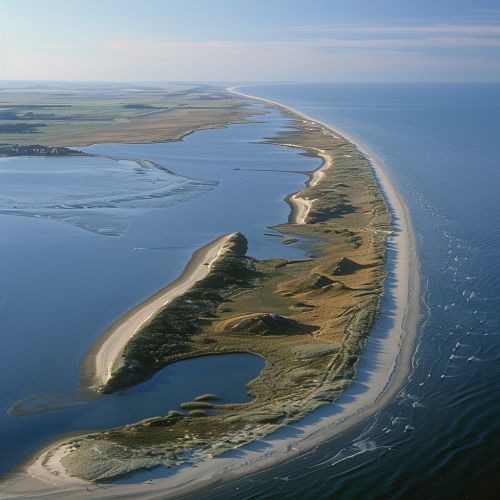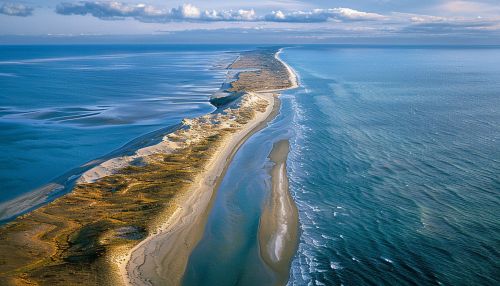Barrier Island
Introduction
A Barrier Island is a long, narrow, offshore deposit of sand or sediment that runs parallel to the coastline of the mainland. They are separated from the mainland by a shallow sound, bay, or lagoon and are often found in chains along the coastlines of continents and islands worldwide. These islands serve as a protective barrier, buffering the mainland from the harsh effects of storms and coastal erosion.
Formation
Barrier islands are formed through a complex process involving ocean currents, waves, tides, and sediment. The process begins with the accumulation of marine sediment along the coastline. Over time, wave action and currents transport this sediment offshore, where it forms a sandbar. As more and more sediment accumulates, the sandbar grows in size and eventually breaches the water's surface, forming an island. This process can take thousands of years to complete.
Characteristics
Barrier islands typically feature a series of dunes, a beach, and a back-barrier. The dunes are the highest point on the island and are formed by wind-blown sand. The beach is the area that faces the ocean and is subject to wave action. The back-barrier, or lagoon, is the area between the barrier island and the mainland. It is typically a shallow, calm body of water with a muddy or sandy bottom.
Ecology
The ecology of barrier islands is unique and diverse, with a variety of habitats including beaches, dunes, marshes, and lagoons. These habitats support a wide range of plant and animal species. The beach and dune areas are typically dominated by grasses and other hardy plants that can withstand the harsh conditions. The marshes and lagoons provide a habitat for a variety of birds, fish, and other wildlife.
Human Interaction
Humans have been interacting with barrier islands for thousands of years. These islands have been used for fishing, hunting, and gathering resources. In more recent times, they have become popular locations for tourism and recreation. However, human activities can have a significant impact on the health and stability of these fragile ecosystems.
Threats and Conservation
Barrier islands face a number of threats, including sea-level rise, storms, and human activities. Sea-level rise can lead to increased coastal erosion and the loss of habitat. Storms can cause significant damage to the islands' infrastructure and ecosystems. Human activities, such as development and pollution, can also have a negative impact. Conservation efforts are focused on protecting these valuable ecosystems and mitigating the impacts of these threats.


